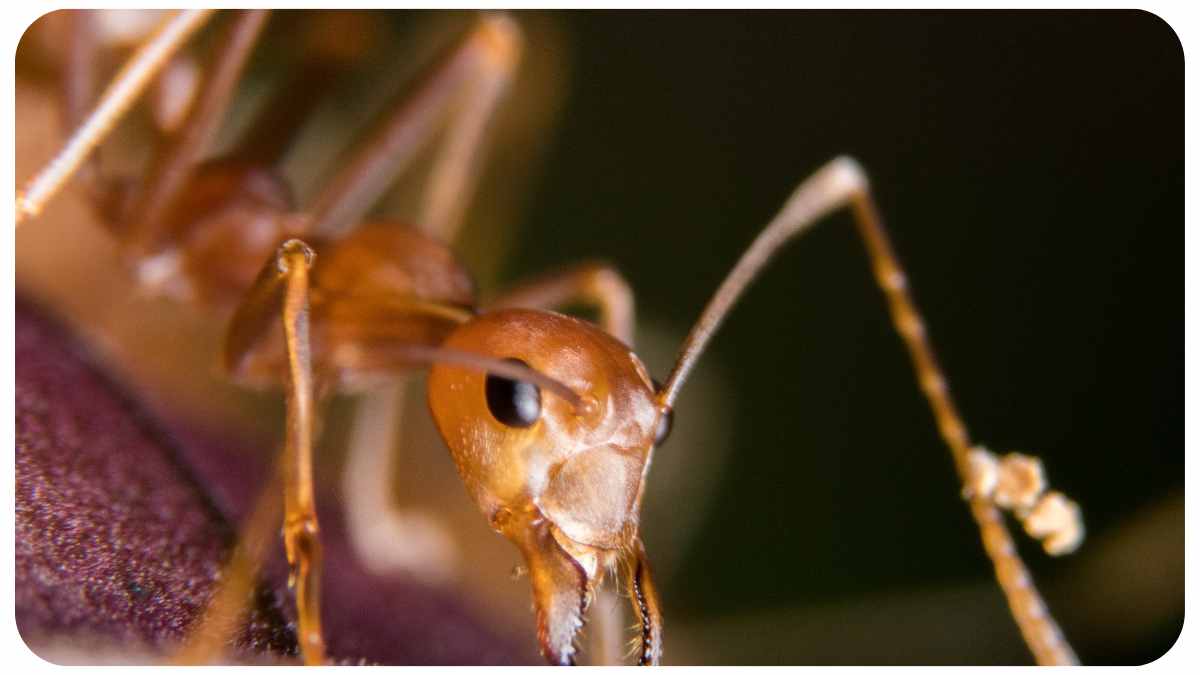Fire ants are not only a nuisance but also a significant health concern. If you see a few of them in your yard or garden, chances are there is a larger colony nearby. In this article, we will discuss how to identify early signs of a fire ant infestation and what you can do to prevent and manage it.
| Takeaways |
|---|
| Early detection of fire ant infestations is crucial for effective management. |
| Prevention is key to managing fire ants. |
| Landscaping techniques, chemical control methods, and biological control methods can all be effective ways to prevent and manage fire ant infestations. |
| Chemical control methods are the most effective way to manage fire ant infestations. |
| Always read and follow label directions when using insecticides and contact a pest management professional if you are unsure how to proceed. |
What are Fire Ants?
Fire ants are reddish-brown ants that belong to the genus Solenopsis. They are native to South America but have spread to other parts of the world, including the United States. Fire ants are highly aggressive and are known for their painful stings. These ants typically build mounds and can be found in lawns, gardens, and other areas with soft soil.
If you’re looking for a simple guide on how to get rid of fire ants, Unified Shields has got you covered. Follow these easy steps highlighted in the article on How to Get Rid of Fire Ants and say goodbye to fire ants once and for all.
Early Signs of a Fire Ant Infestation
Early detection of fire ant infestations is crucial for effective management. Here are some signs to look out for:
Mounds
Fire ants build mounds in open areas of soil, which can range from a few inches to several feet in diameter. These mounds have a distinctive appearance, with a flattened top and no visible entrance hole.
Foraging Behavior
Fire ants are constantly foraging for food and can often be seen traveling in trails. If you notice a large number of ants moving in a particular direction, it could be a sign of an infestation.
Bites and Stings
Fire ants are aggressive and will sting anything they perceive as a threat. If you or your pets have been bitten or stung by fire ants, it’s a clear indication of their presence.
Do you know the signs of an ant infestation to watch out for? If not, check out Unified Shields’ guide on Signs of an Ant Infestation to Watch For and learn how to identify ant infestations in your home.
Damaged Plants
Fire ants feed on plant sap and can cause significant damage to trees, shrubs, and other vegetation. If you notice wilting, yellowing, or other signs of plant stress, it could be due to a fire ant infestation.
Identifying Fire Ants
It’s essential to be able to identify fire ants correctly to manage infestations effectively. Here are some characteristics of fire ants:
Appearance
Fire ants are reddish-brown in color and range in size from 1/16 to 1/4 inch in length. They have a two-segmented “waist” and a stinger at the end of their abdomen.
Behavior
Fire ants are highly aggressive and will sting anything they perceive as a threat. They build mounds in open areas of soil and are constantly foraging for food.
Distribution
Fire ants are most commonly found in the southern United States but have also been reported in other areas of the country. They thrive in warm, moist climates and can be found in lawns, gardens, and other areas with soft soil.
Want to know how to keep ants away using simple methods? Unified Shields has got you covered. Check out our guide on how to prevent ants from taking over your home using easy methods that work
Preventing Fire Ant Infestations
Prevention is the key to managing fire ants. Here are some landscaping techniques and chemical and biological control methods you can use to prevent fire ant infestations:
| Preventative Measure | Description |
|---|---|
| Remove potential nesting sites | Fire ants often build their nests in piles of wood or debris, so removing these potential nesting sites can help prevent an infestation. |
| Keep your lawn trimmed and tidy | Fire ants are attracted to tall grass and weeds, so keeping your lawn trimmed and tidy can help deter them from nesting on your property. |
| Cover trash cans and clean up food waste | Fire ants are attracted to food waste, so covering your trash cans and cleaning up any food spills or waste promptly can help prevent an infestation. |
| Seal cracks and openings | Fire ants can enter your home through cracks and openings around doors, windows, and walls. Sealing these openings can help prevent them from entering your home. |
| Use insecticides or bait stations | Insecticides or bait stations specifically designed for fire ants can be an effective way to prevent an infestation. However, it’s important to use these products properly and follow all safety guidelines. |
Landscaping Techniques
Keeping your lawn and garden healthy is an effective way to prevent fire ant infestations. Here are some tips:
- Mow your lawn regularly to keep it short.
- Remove debris and other potential nesting sites.
- Water your lawn and garden deeply and infrequently to discourage fire ants from nesting in the soil.
Chemical Control Methods
Chemical control methods are an effective way to prevent and manage fire ant infestations. Here are some options:
- Broadcast insecticides: These are applied to the entire lawn or garden and kill fire ants on contact.
- Individual mound treatments: These are applied directly to fire ant mounds and can be more targeted than broadcast insecticides.
- Baits: These are slow-acting insecticides that fire ants take back to their colony, killing the entire colony.
If ants in the kitchen are driving you crazy, Unified Shields can help. Our guide on How to Get Rid of Ants in the Kitchen – Pro Tips provides practical tips to help you banish ants from your kitchen for good
Biological Control Methods
Biological control methods use natural enemies of fire ants to control infestations. Here are some options:
- Entomopathogenic fungi: These fungi infect and kill fire ants.
- Parasitic flies: These flies lay their eggs on fire ants, and the resulting larvae feed on the ants, eventually killing them.
Managing Fire Ant Infestations
If you already have a fire ant infestation, here are some management strategies you can use:
Chemical Control Methods
Chemical control methods are the most effective way to manage fire ant infestations. Here are some options:
- Baits: These are slow-acting insecticides that fire ants take back to their colony, killing the entire colony.
- Individual mound treatments: These are applied directly to fire ant mounds and can be more targeted than broadcast insecticides.
Baiting
Baiting involves placing slow-acting insecticides in areas where fire ants are active. The fire ants will take the bait back to their colony, killing the entire colony.
Individual Mound Treatments
Individual mound treatments involve applying insecticides directly to fire ant mounds. This method can be more targeted than broadcast insecticides.
Are you tired of dealing with ants in your home? At Unified Shields, we understand your frustration. That’s why we created a guide on How to Get Rid of Ants Permanently – Experience, where you’ll find proven methods that will help you get rid of ants once and for all.
Biological Control Methods
Biological control methods use natural enemies of fire ants to manage infestations. Here are some options:
- Entomopathogenic fungi: These fungi infect and kill fire ants.
- Parasitic flies: These flies lay their eggs on fire ants, and the resulting larvae feed on the ants, eventually killing them.
Conclusion
Overall, fire ants are a significant concern for homeowners and gardeners, and early detection is crucial for effective management. By knowing the early signs of a fire ant infestation, identifying fire ants correctly, and using landscaping techniques and chemical and biological control methods, you can prevent and manage fire ant infestations effectively.
Remember to always read and follow label directions when using insecticides and contact a pest management professional if you are unsure how to proceed.
Further Reading
Here are some additional resources that you may find helpful in learning more about fire ants:
Western Exterminator: Fire Ants in Your Home – This article provides information on identifying fire ants and managing infestations in your home.
Orkin: Fire Ants – Orkin offers information on fire ant biology, behavior, and management strategies.
WebMD: Black Fire Ants – This WebMD article offers an overview of black fire ants, their behavior, and management.
FAQs
What are fire ants?
Fire ants are reddish-brown ants that are highly aggressive and known for their painful stings. They are native to South America but have spread to other parts of the world, including the United States.
How do I know if I have a fire ant infestation?
Early signs of a fire ant infestation include mounds, foraging behavior, bites and stings, and damaged plants. You can also identify fire ants by their reddish-brown color and two-segmented “waist.”
What should I do if I discover a fire ant infestation?
If you discover a fire ant infestation, it’s important to take action immediately to prevent the infestation from spreading. Landscaping techniques, chemical control methods, and biological control methods can all be effective ways to manage fire ant infestations.
Are fire ants dangerous?
Yes, fire ants can be dangerous, especially to people with allergies or other health concerns. Their painful stings can cause itching, swelling, and in rare cases, anaphylaxis.
Can I manage a fire ant infestation on my own?
While some homeowners may be able to manage small fire ant infestations on their own, larger infestations may require the assistance of a pest management professional. It’s important to always read and follow label directions when using insecticides and to contact a professional if you are unsure how to proceed.

Hello! I’m Hellen James, and I write about how to keep pests from invading your home. For the last 10 years, I’ve been working in pest control and am excited to share my expertise with you!


